Search the Special Collections and Archives Portal
Search Results
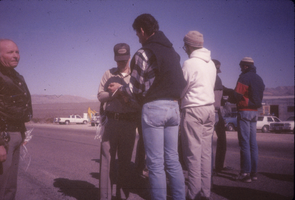
Slide of protester getting arrested at a demonstration near the Nevada Test Site, March 24, 1989
Date
1989-03-24
Archival Collection
Description
Color image of protester getting arrested at an anti-nuclear testing demonstration held in the Nevada desert on Good Friday.
Image
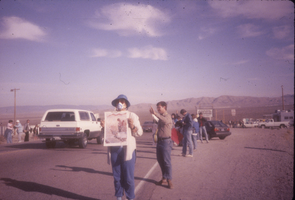
Slide of protester wearing a surgical mask at a demonstration near the Nevada Test Site, March 24, 1989
Date
1989-03-24
Archival Collection
Description
Color image of protesters at an anti-nuclear testing demonstration held in the Nevada desert on Good Friday. One is wearing a surgical mask and holding a sign.
Image
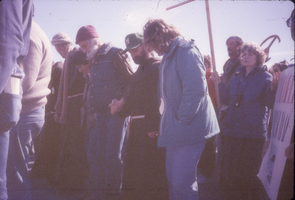
Slide of protesters with their heads bowed in prayer at a demonstration near the Nevada Test Site, March 24, 1989
Date
1989-03-24
Archival Collection
Description
Color image of protesters with their heads bowed in prayer at an anti-nuclear testing demonstration held in the Nevada desert on Good Friday.
Image
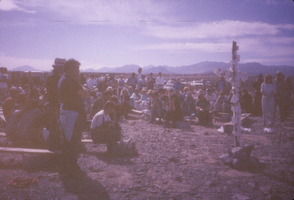
Slide of protesters seated by a wooden cross at a demonstration near the Nevada Test Site, March 24, 1989
Date
1989-03-24
Archival Collection
Description
Color image of protesters seated near a large wooden cross covered in papers at an anti-nuclear testing demonstration held in the Nevada desert on Good Friday. The names of nuclear tests have been written on the papers and nailed to the cross.
Image
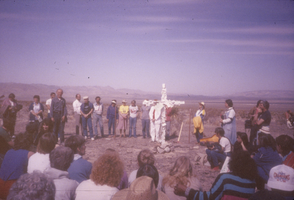
Slide of protesters by a wooden cross at a demonstration near the Nevada Test Site, March 24, 1989
Date
1989-03-24
Archival Collection
Description
Color image of protesters around a large wooden cross covered in papers at an anti-nuclear testing demonstration held in the Nevada desert on Good Friday. The names of nuclear tests have been written on the papers and nailed to the cross.
Image
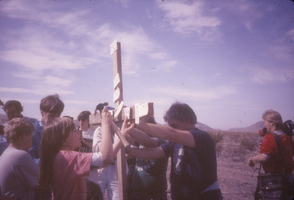
Slide of protesters nailing papers to a large wooden cross at a demonstration near the Nevada Test Site, March 24, 1989
Date
1989-03-24
Archival Collection
Description
Color image of protesters nailing papers to a large wooden cross at an anti-nuclear testing demonstration held in the Nevada desert on Good Friday. The names of nuclear tests have been written on the papers.
Image
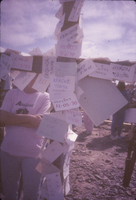
Slide of a large wooden cross covered in paper signs at a demonstration near the Nevada Test Site, March 24, 1989
Date
1989-03-24
Archival Collection
Description
Color image of protesters near a large wooden cross covered in small pieces of paper at an anti-nuclear testing demonstration held on Good Friday. The names of nuclear tests have been written on the papers and nailed to the cross.
Image
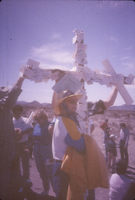
Slide of protesters with a large wooden cross covered in paper at a demonstration near the Nevada Test Site, March 24, 1989
Date
1989-03-24
Archival Collection
Description
Color image of protesters near a large wooden cross covered in small pieces of paper at an anti-nuclear testing demonstration held on Good Friday. The names of nuclear tests have been written on the papers and nailed to the cross.
Image
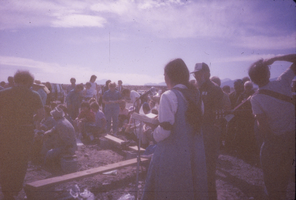
Slide of protesters at a demonstration held on Good Friday near the Nevada Test Site, March 24, 1989
Date
1989-03-24
Archival Collection
Description
Color image of protesters at an anti-nuclear testing demonstration held in the Nevada desert on Good Friday.
Image
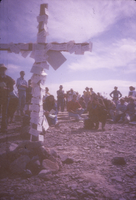
Slide of protesters with a large wooden cross covered in paper at a demonstration near the Nevada Test Site, March 24, 1989
Date
1989-03-24
Archival Collection
Description
Color image of protesters near a large wooden cross covered in small pieces of paper at an anti-nuclear testing demonstration held on Good Friday. The names of nuclear tests have been written on the papers and nailed to the cross.
Image
Pagination
Refine my results
Content Type
Creator or Contributor
Subject
Archival Collection
Digital Project
Resource Type
Year
Material Type
Place
Language
Records Classification
